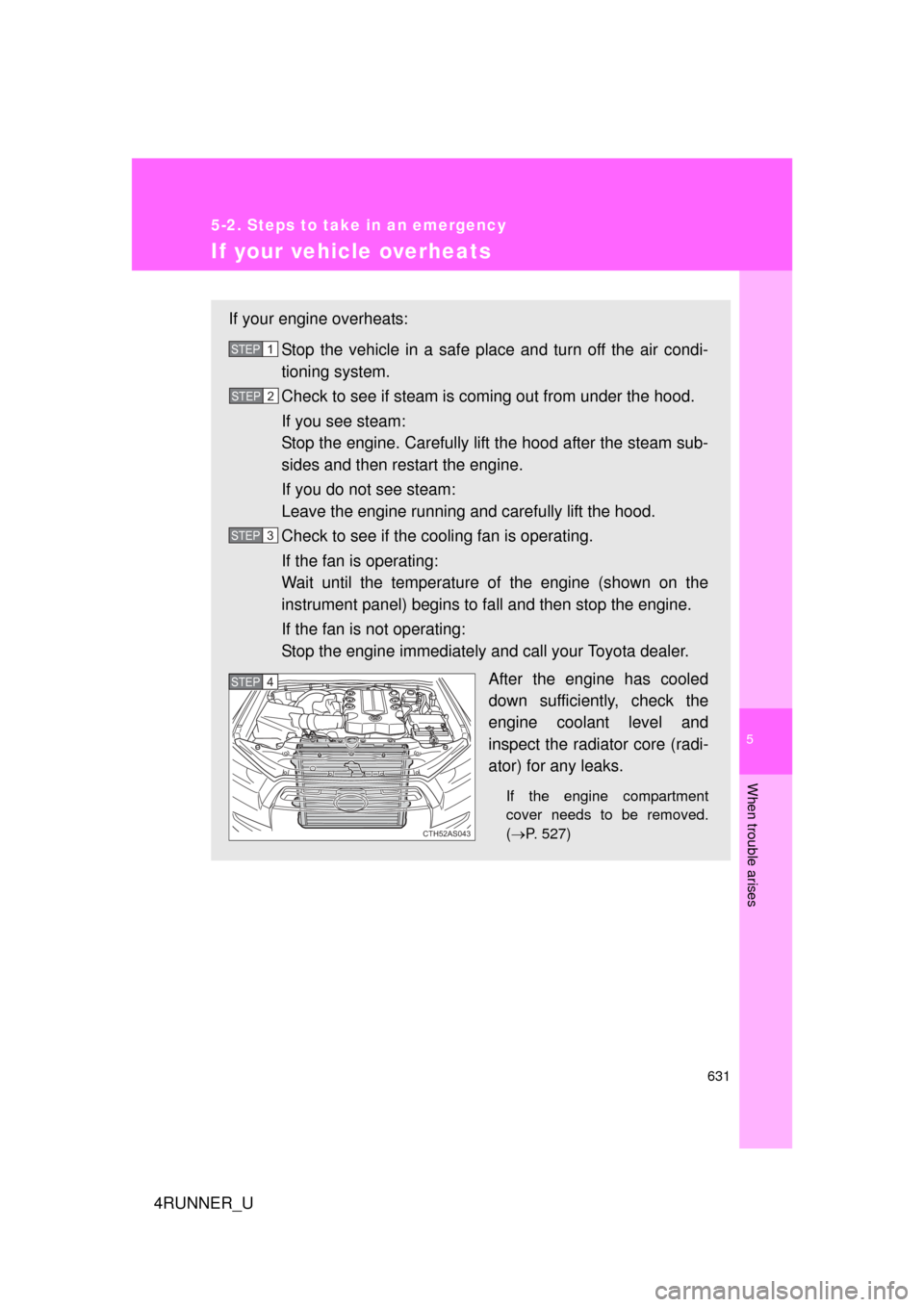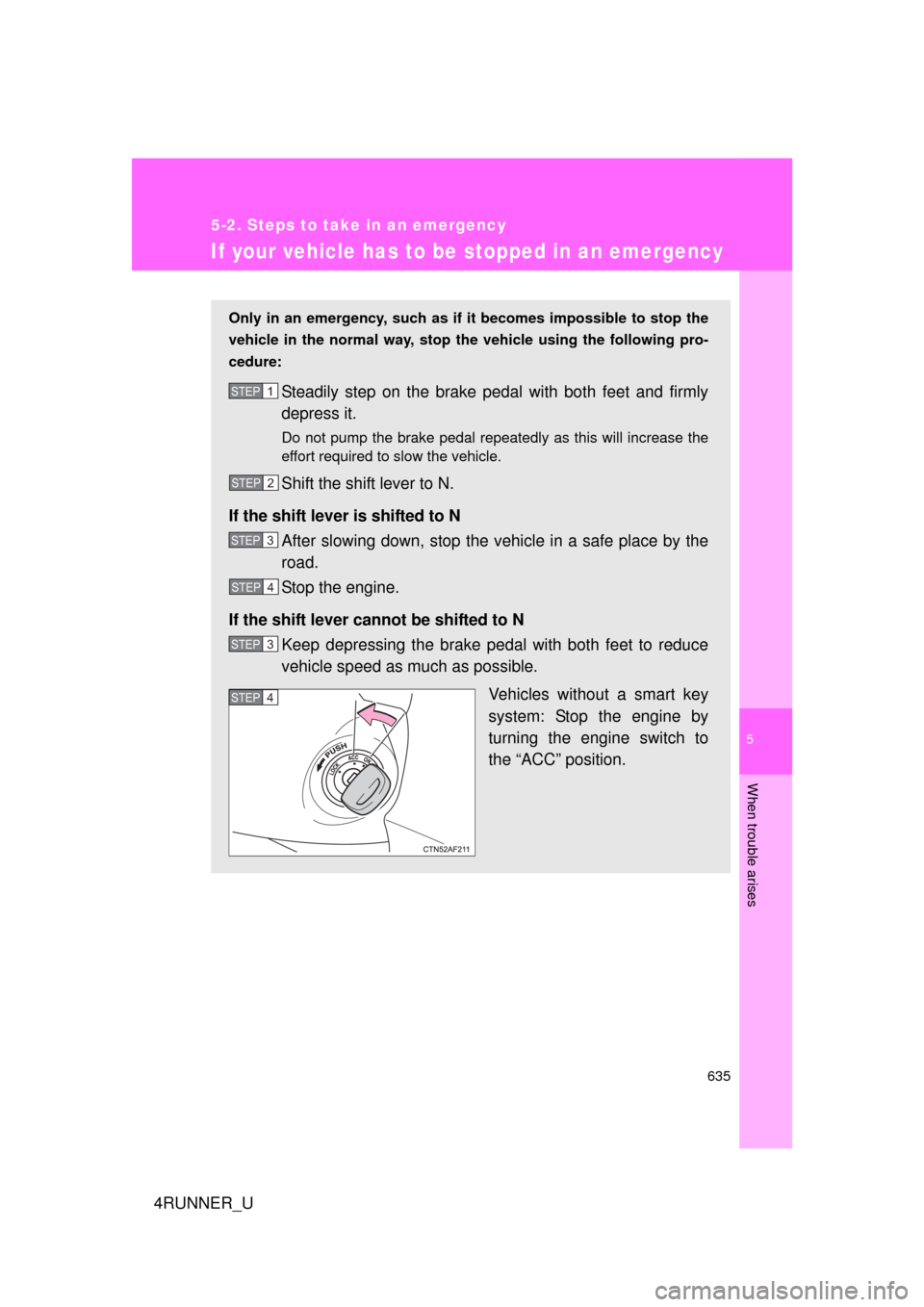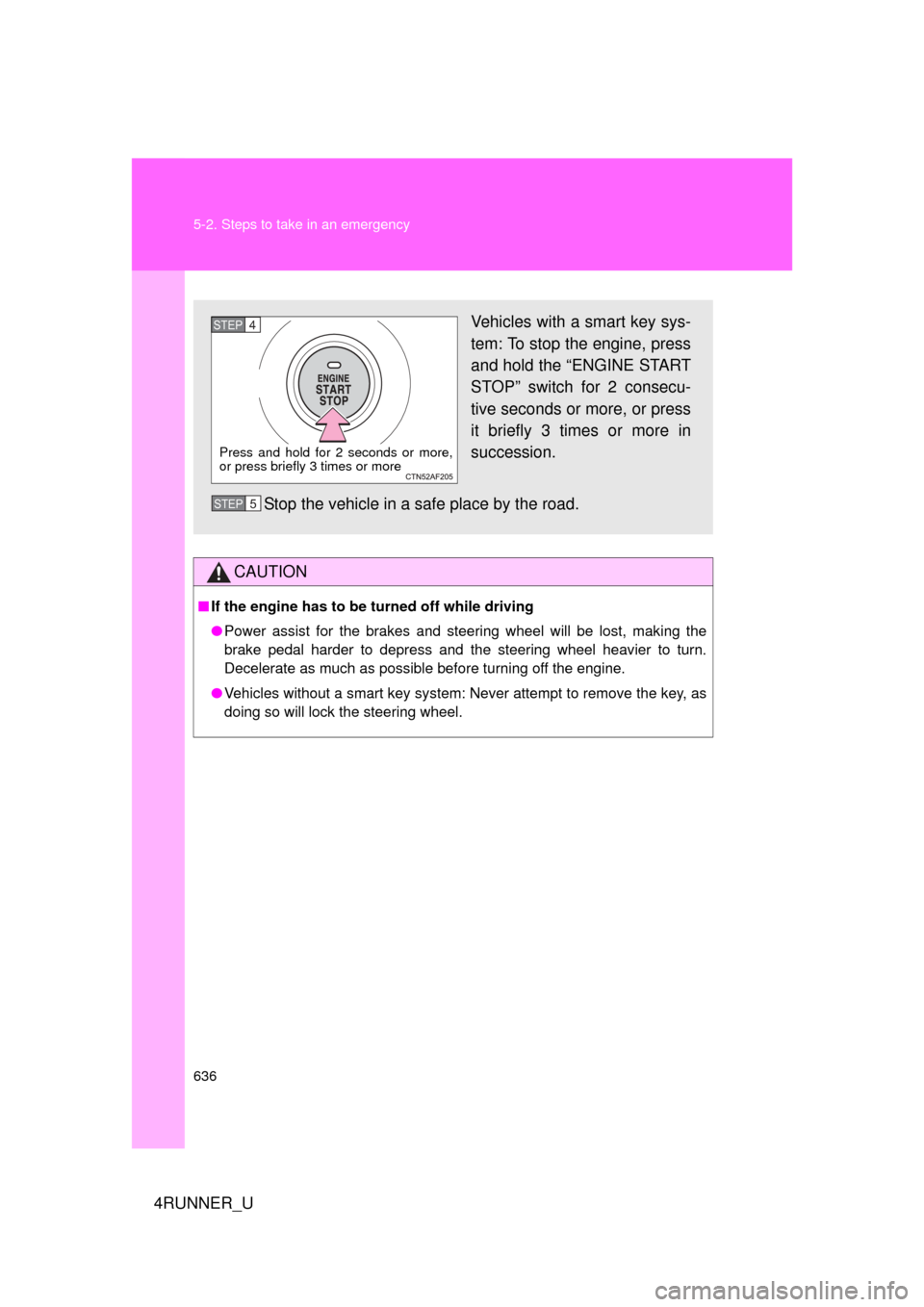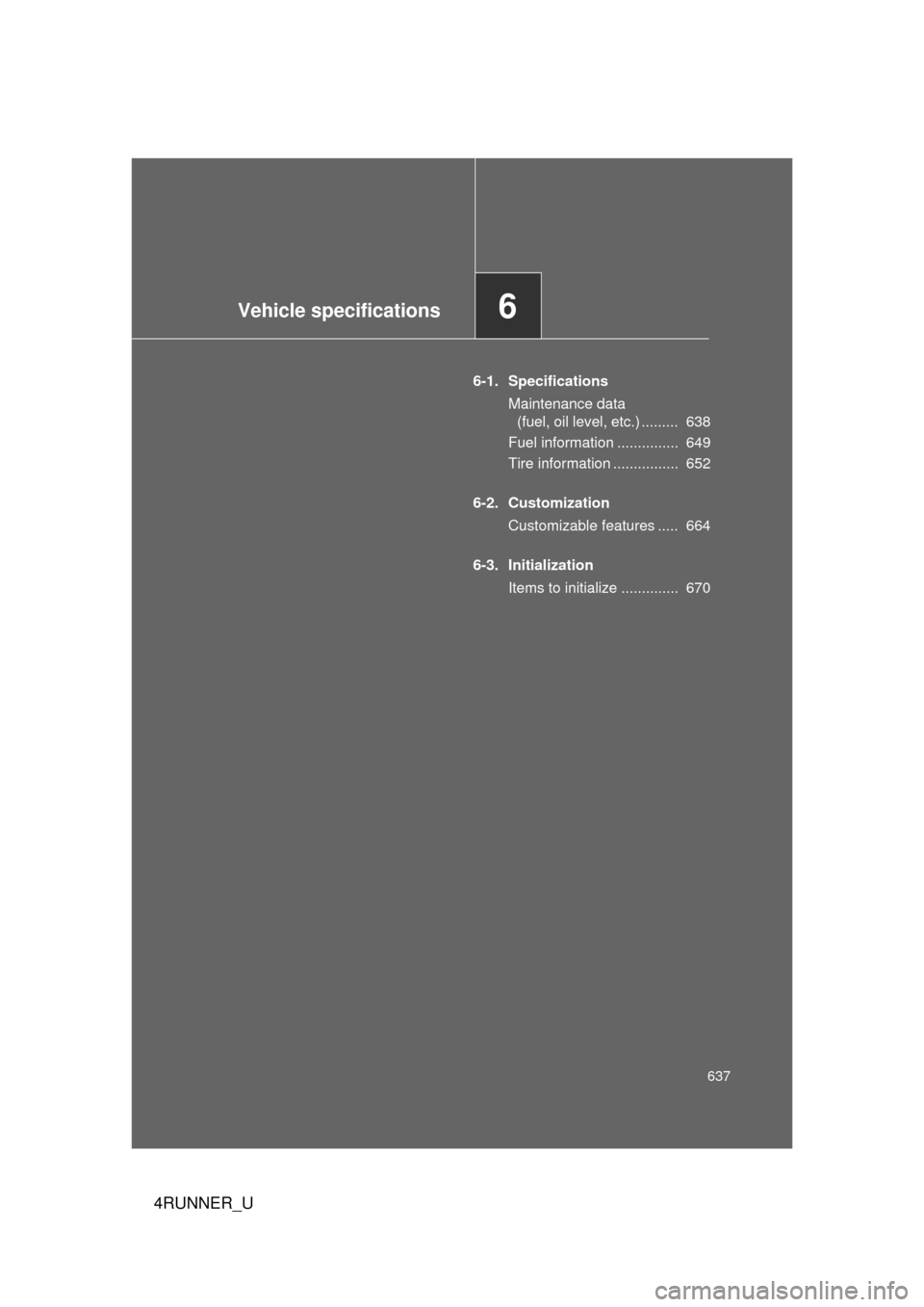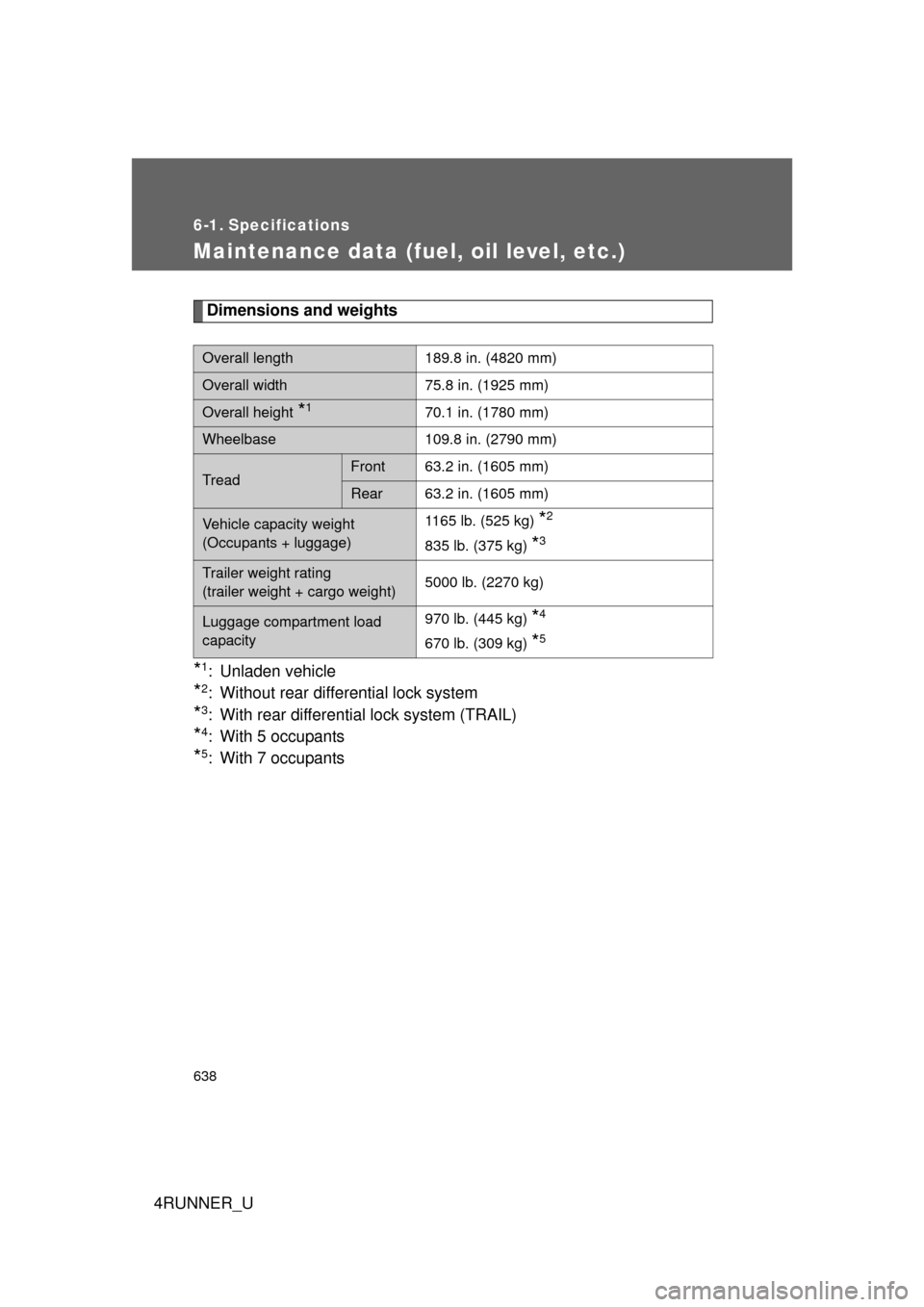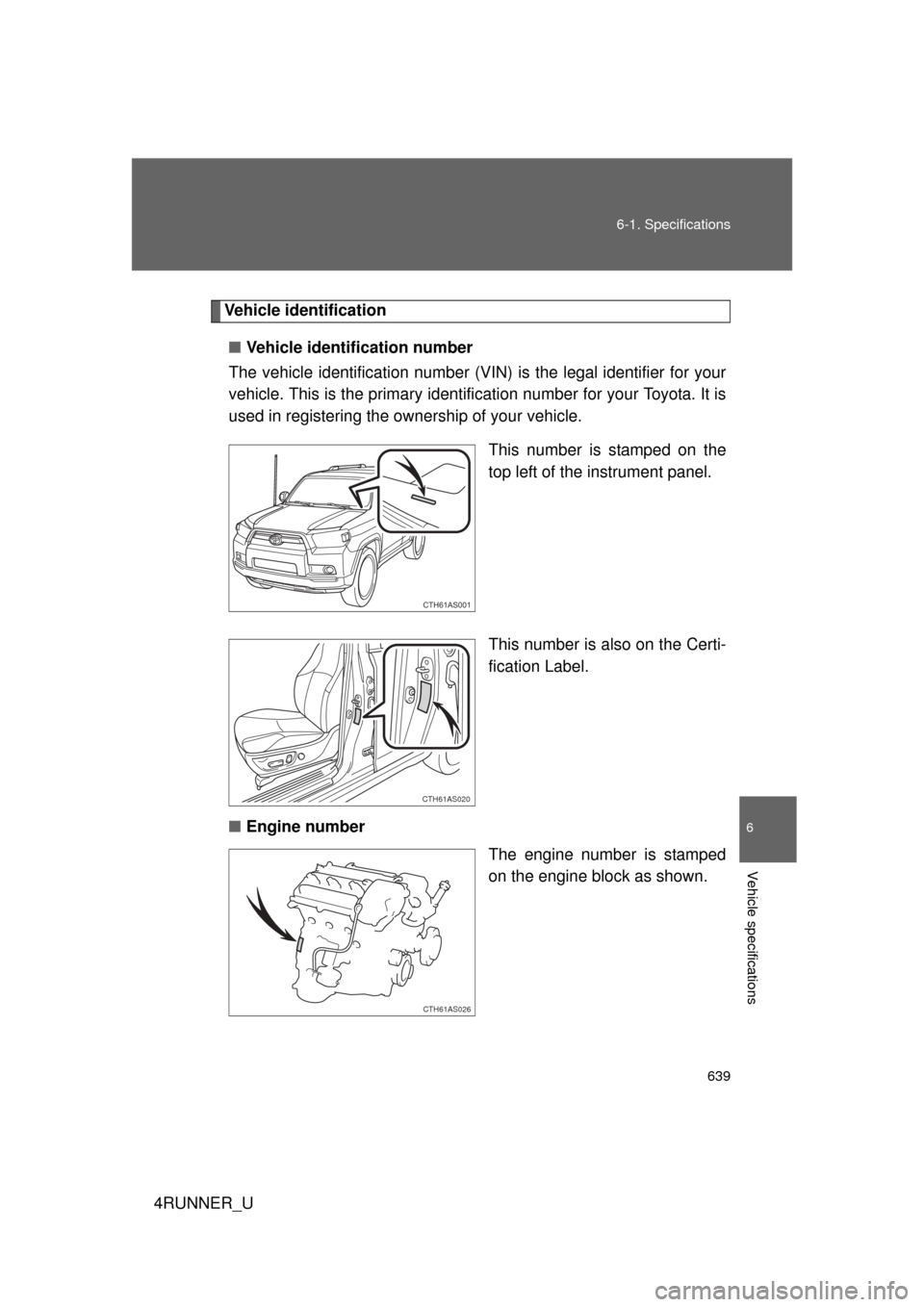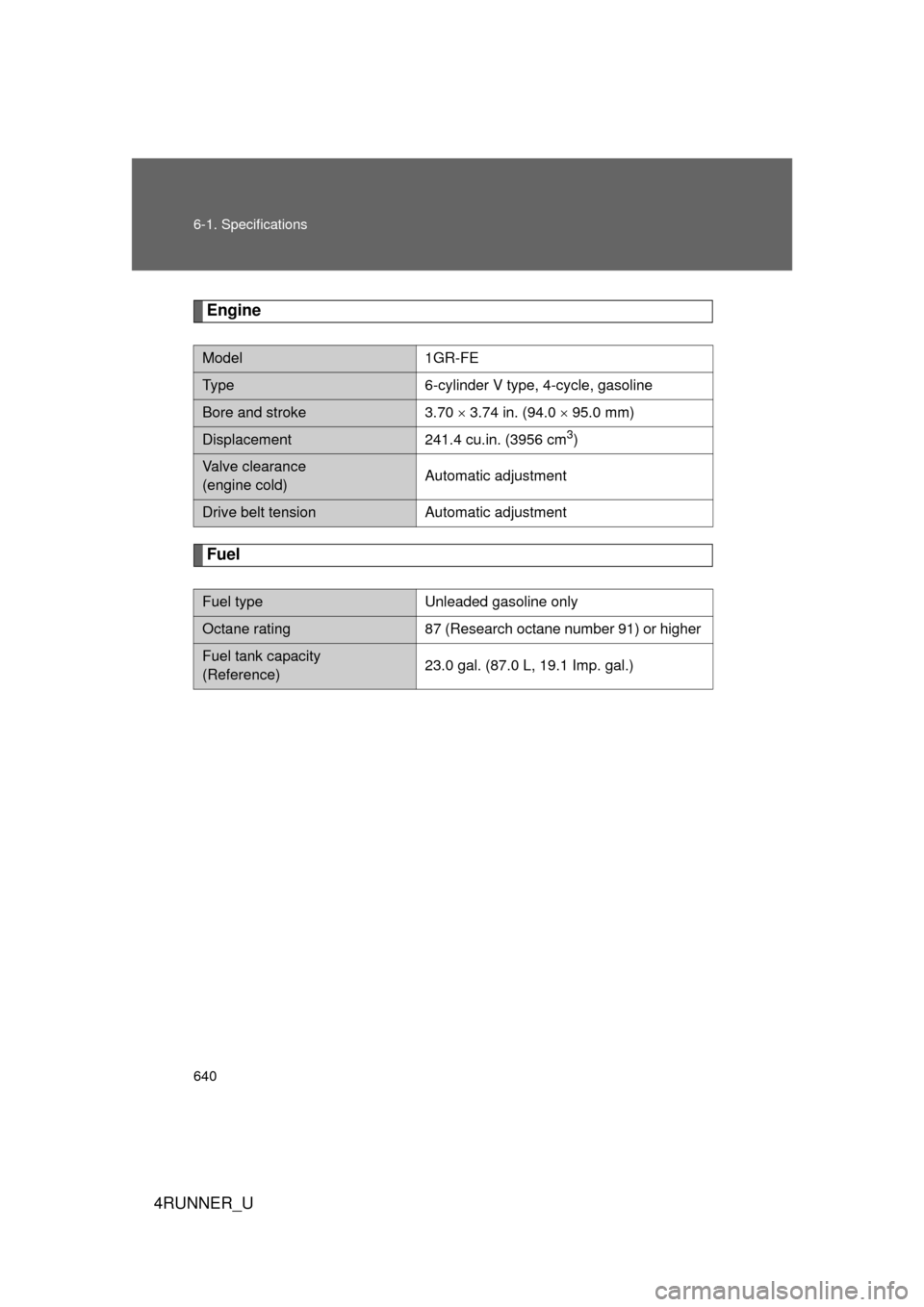TOYOTA 4RUNNER 2013 N280 / 5.G Owners Manual
4RUNNER 2013 N280 / 5.G
TOYOTA
TOYOTA
https://www.carmanualsonline.info/img/14/6111/w960_6111-0.png
TOYOTA 4RUNNER 2013 N280 / 5.G Owners Manual
Trending: turn signal bulb, window, tire size, length, cruise control, buttons, lights
Page 631 of 704
5
When trouble arises
631
5-2. Steps to take in an emergency
4RUNNER_U
If your vehicle overheats
If your engine overheats:Stop the vehicle in a safe place and turn off the air condi-
tioning system.
Check to see if steam is coming out from under the hood.
If you see steam:
Stop the engine. Carefully lift the hood after the steam sub-
sides and then restart the engine.
If you do not see steam:
Leave the engine running and carefully lift the hood.
Check to see if the cooling fan is operating.
If the fan is operating:
Wait until the temperature of the engine (shown on the
instrument panel) begins to fall and then stop the engine.
If the fan is not operating:
Stop the engine immediately and call your Toyota dealer. After the engine has cooled
down sufficiently, check the
engine coolant level and
inspect the radiator core (radi-
ator) for any leaks.
If the engine compartment
cover needs to be removed.
(P. 527)
STEP 1
STEP 2
STEP 3
CTH52AS043
STEP 4
Page 632 of 704
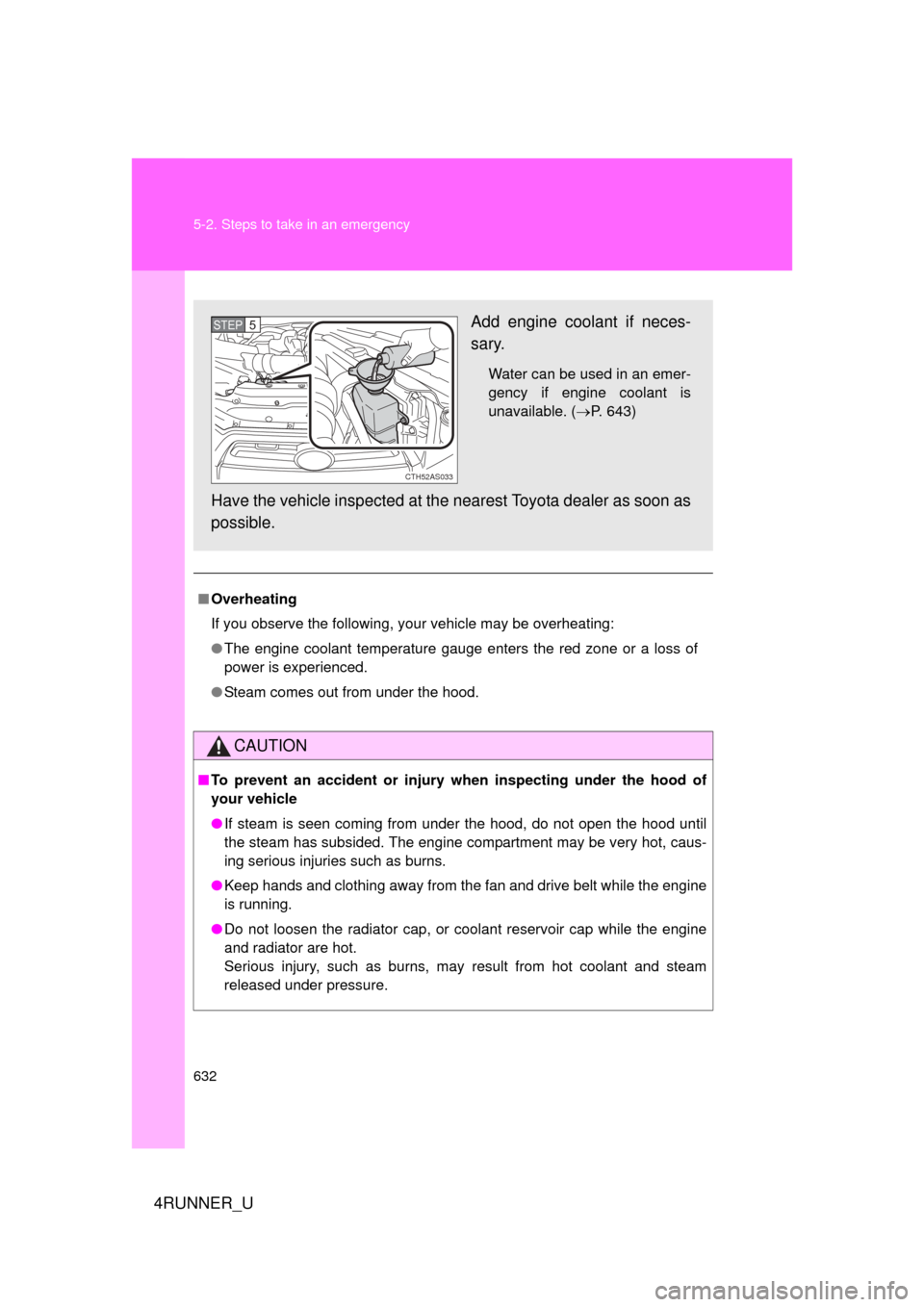
632 5-2. Steps to take in an emergency
4RUNNER_U
■Overheating
If you observe the following, your vehicle may be overheating:
● The engine coolant temperature gauge enters the red zone or a loss of
power is experienced.
● Steam comes out from under the hood.
CAUTION
■To prevent an accident or injury when inspecting under the hood of
your vehicle
● If steam is seen coming from under the hood, do not open the hood until
the steam has subsided. The engine compartment may be very hot, caus-
ing serious injuries such as burns.
● Keep hands and clothing away from the fan and drive belt while the engine
is running.
● Do not loosen the radiator cap, or coolant reservoir cap while the engine
and radiator are hot.
Serious injury, such as burns, may result from hot coolant and steam
released under pressure.
Add engine coolant if neces-
sary.
Water can be used in an emer-
gency if engine coolant is
unavailable. ( P. 643)
Have the vehicle inspected at the nearest Toyota dealer as soon as
possible.
CTH52AS033
STEP 5
Page 633 of 704
5
When trouble arises
633
5-2. Steps to take in an emergency
4RUNNER_U
NOTICE
■
When adding engine coolant
Wait until the engine has cooled down before adding engine coolant.
When adding coolant, do so slowly. Adding cool coolant to a hot engine too
quickly can cause damage to the engine.
Page 634 of 704
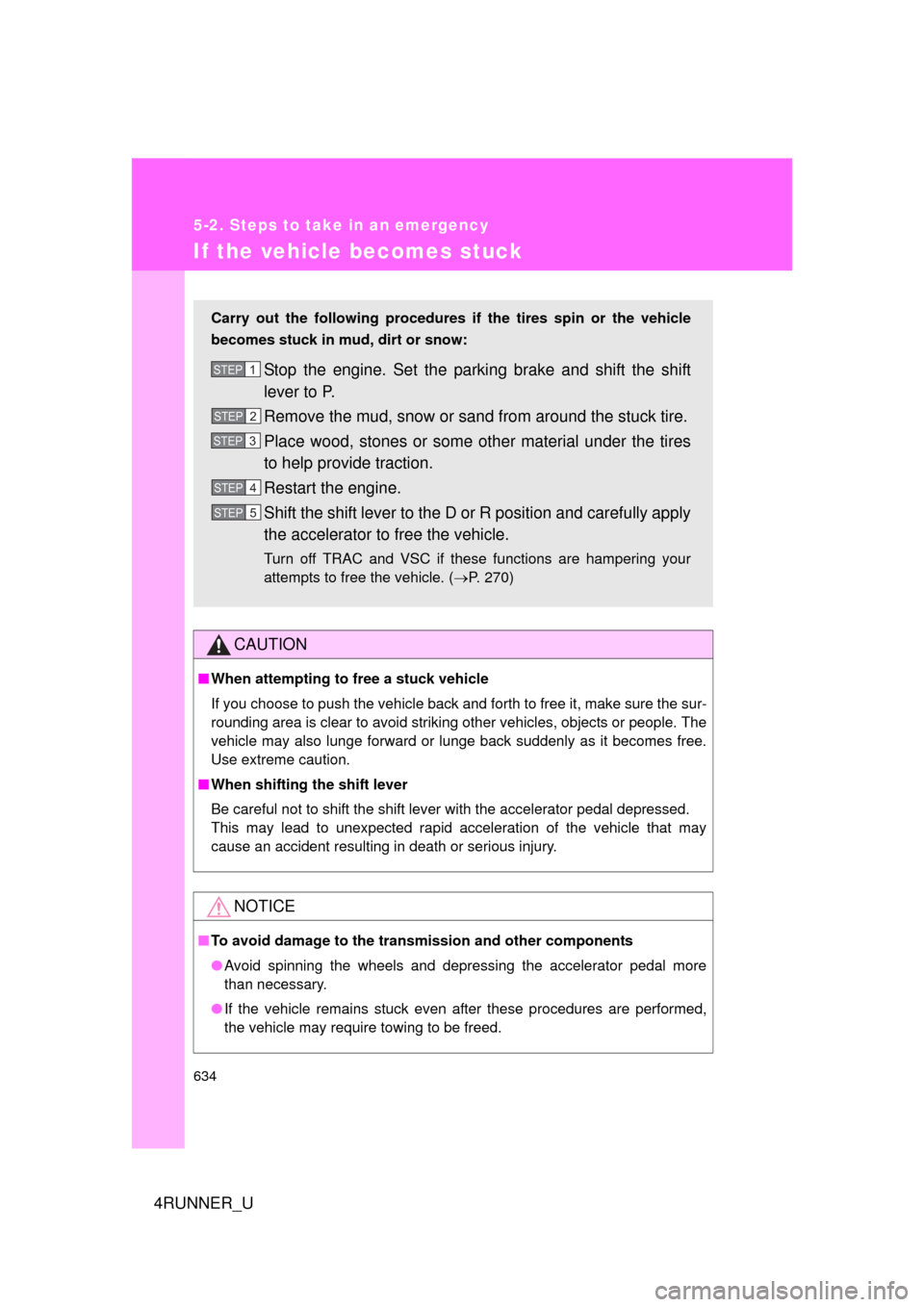
634
5-2. Steps to take in an emergency
4RUNNER_U
If the vehicle becomes stuck
CAUTION
■When attempting to free a stuck vehicle
If you choose to push the vehicle back and forth to free it, make sure the sur-
rounding area is clear to avoid striking other vehicles, objects or people. The
vehicle may also lunge forward or lunge back suddenly as it becomes free.
Use extreme caution.
■ When shifting the shift lever
Be careful not to shift the shift lever with the accelerator pedal depressed.
This may lead to unexpected rapid acceleration of the vehicle that may
cause an accident resulting in death or serious injury.
NOTICE
■To avoid damage to the transmission and other components
● Avoid spinning the wheels and depressing the accelerator pedal more
than necessary.
● If the vehicle remains stuck even after these procedures are performed,
the vehicle may require towing to be freed.
Carry out the following procedures if the tires spin or the vehicle
becomes stuck in mud, dirt or snow:
Stop the engine. Set the parki ng brake and shift the shift
lever to P.
Remove the mud, snow or sand from around the stuck tire.
Place wood, stones or some other material under the tires
to help provide traction.
Restart the engine.
Shift the shift lever to the D or R position and carefully apply
the accelerator to free the vehicle.
Turn off TRAC and VSC if these functions are hampering your
attempts to free the vehicle. ( P. 270)
STEP 1
STEP 2
STEP 3
STEP 4
STEP 5
Page 635 of 704
5
When trouble arises
635
5-2. Steps to take in an emergency
4RUNNER_U
If your vehicle has to be stopped in an emergency
Only in an emergency, such as if it becomes impossible to stop the
vehicle in the normal way, stop the vehicle using the following pro-
cedure:
Steadily step on the brake pedal with both feet and firmly
depress it.
Do not pump the brake pedal repeatedly as this will increase the
effort required to slow the vehicle.
Shift the shift lever to N.
If the shift lever is shifted to N After slowing down, stop the vehi cle in a safe place by the
road.
Stop the engine.
If the shift lever cannot be shifted to N Keep depressing the brake pedal with both feet to reduce
vehicle speed as much as possible.
Vehicles without a smart key
system: Stop the engine by
turning the engine switch to
the “ACC” position.
STEP 1
STEP 2
STEP 3
STEP 4
STEP 3
STEP 4
Page 636 of 704
636 5-2. Steps to take in an emergency
4RUNNER_U
CAUTION
■If the engine has to be turned off while driving
● Power assist for the brakes and steering wheel will be lost, making the
brake pedal harder to depress and the steering wheel heavier to turn.
Decelerate as much as possible before turning off the engine.
● Vehicles without a smart key system: Never attempt to remove the key, as
doing so will lock the steering wheel.
Vehicles with a smart key sys-
tem: To stop the engine, press
and hold the “ENGINE START
STOP” switch for 2 consecu-
tive seconds or more, or press
it briefly 3 times or more in
succession.
Stop the vehicle in a safe place by the road.STEP 4
Press and hold for 2 seconds or more,
or press briefly 3 times or more
STEP 5
Page 637 of 704
Vehicle specifications6
637
4RUNNER_U
6-1. SpecificationsMaintenance data (fuel, oil level, etc.) ......... 638
Fuel information ............... 649
Tire information ................ 652
6-2. Customization Customizable features ..... 664
6-3. Initialization Items to initialize .............. 670
Page 638 of 704
638
4RUNNER_U
6-1. Specifications
Maintenance data (fuel, oil level, etc.)
Dimensions and weights
*1: Unladen vehicle
*2: Without rear differential lock system
*3: With rear differential lock system (TRAIL)
*4: With 5 occupants
*5: With 7 occupants
Overall length189.8 in. (4820 mm)
Overall width75.8 in. (1925 mm)
Overall height *170.1 in. (1780 mm)
Wheelbase109.8 in. (2790 mm)
TreadFront63.2 in. (1605 mm)
Rear63.2 in. (1605 mm)
Vehicle capacity weight
(Occupants + luggage)1165 lb. (525 kg) *2
835 lb. (375 kg) *3
Trailer weight rating
(trailer weight + cargo weight)5000 lb. (2270 kg)
Luggage compartment load
capacity970 lb. (445 kg) *4
670 lb. (309 kg) *5
Page 639 of 704
639
6-1. Specifications
6
Vehicle specifications
4RUNNER_U
Vehicle identification
■ Vehicle identification number
The vehicle identificati on number (VIN) is the legal identifier for your
vehicle. This is the primary identification number for your Toyota. It is
used in registering the ownership of your vehicle.
This number is stamped on the
top left of the instrument panel.
This number is also on the Certi-
fication Label.
■ Engine number
The engine number is stamped
on the engine block as shown.
CTH61AS001
CTH61AS020
CTH61AS026
Page 640 of 704
640 6-1. Specifications
4RUNNER_U
Engine
Fuel
Model1GR-FE
Ty pe6-cylinder V type, 4-cycle, gasoline
Bore and stroke3.70 3.74 in. (94.0 95.0 mm)
Displacement241.4 cu.in. (3956 cm3)
Valve clearance
(engine cold)Automatic adjustment
Drive belt tensionAutomatic adjustment
Fuel typeUnleaded gasoline only
Octane rating87 (Research octane number 91) or higher
Fuel tank capacity
(Reference)23.0 gal. (87.0 L, 19.1 Imp. gal.)
Trending: garage door opener, wheelbase, airbag disable, snow chains, seats, fuel fill door release, towing
